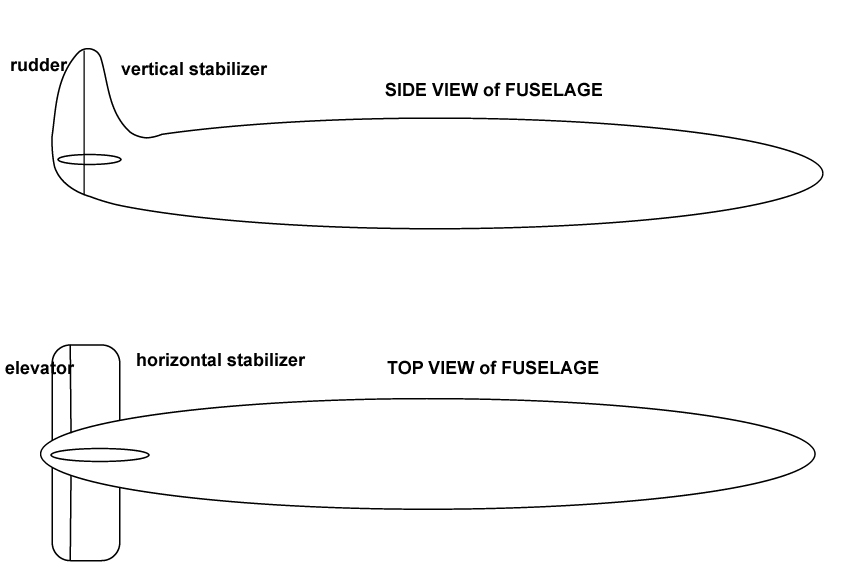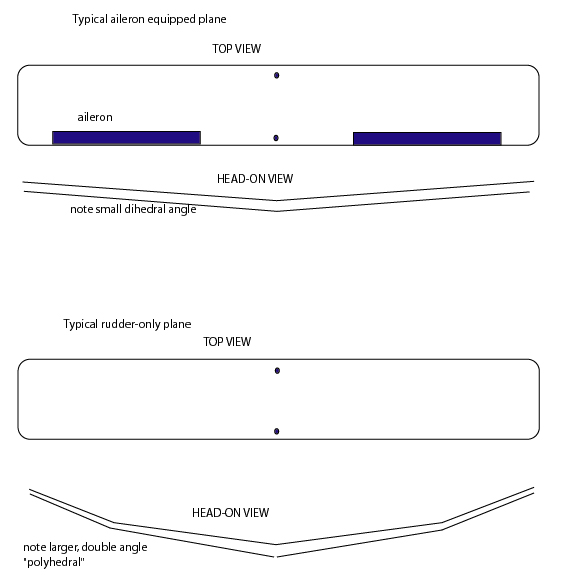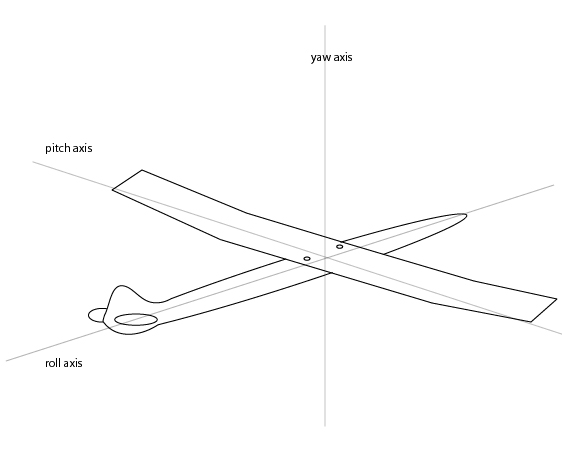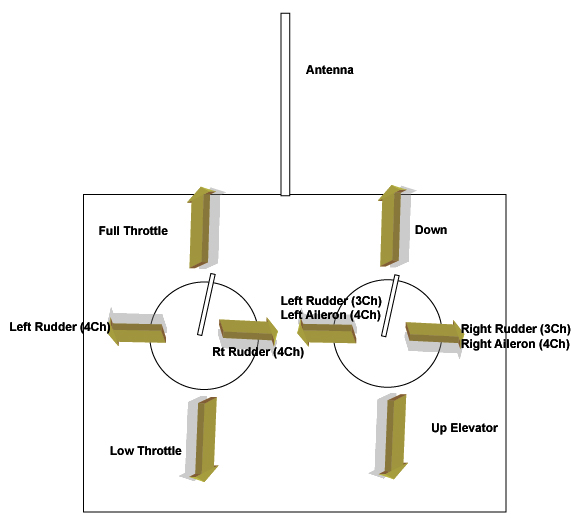What do all the RC Airplane Controls really do?
Some definitions: Rudder - The movable part at the back of the vertical fin. Causes the airplane to rotate left or right (yaw) about a vertical axis.
Elevator - The movable part at the back of the horizontal stab. Causes the airplane to rotate up or down (pitch) about a horizontal axis.
Aileron - The movable part at the back of the wing. Causes the airplane to roll left or right.
Throttle - The device (mechanical or electronic) that cause the airplane's engine or motor to speed up.
See the diagrams below for sketches of your typical radio control airplane. In particular, note the different wing configurations and the locations of all the control surfaces.


Now this drawing shows each "axis" of rotation of the airplane. You can imagine the controls rotating the airplane around these three different lines.

Now see the diagram below for sketch of your typical 4 channel radio. Note that there are two sticks that can move back and forth or side to side.
The setup shown is the typical "Mode 2" arrangement.
These pages assume that you have a Mode 2 setup. (There is also a Mode 1 setup, less commonly seen in North America).

Note that if your airplane only has three channels, the rudder control will be on the right stick. This will be the turning control.
For a 4 channel airplane, ailerons will be on the right stick (main turning control) and rudder on the left (used for turning assist, ground steering, aerobatics).
The elevator control is also on the right stick. Forward is down elevator and back is up elevator. The throttle is on the left stick.
Let's look in greater detail at what these controls do:
Turning
Consider first the 4 channel airplane with ailerons. To initiate a left turn, left aileron is applied by moving the right control stick to the left. This in turn causes the left aileron on the wing to move upwards, while the right aileron moves downwards.
Increased air pressure on the left aileron will cause the left wing to roll downwards, and presto, the airplane has rolled left. Now if a bit of up elevator is applied while the airplane is banked over, the nose of the plane will tend to rotate around. So aileron to roll plus elevator results in a turn.
Some planes also benefit from the application of a little rudder in the turns, but many fliers skip that fine detail (this comes back to haunt people when they learn to fly helicopters :) ).
Now consider the 3 channel rudder only plane. The rudder actually causes the plane to pivot about the vertical yaw axis, not the roll axis (see diagram).
So how is it possible that the rudder can roll / turn the airplane? Well, let's say that left rudder is applied. The plan yaws to the left. Now, the angle of attack of the right wing has increased, i.e. the angle of the wing relative to the airstream has increased. (Another way to look at this is that the right wing has rotated partially forward, exposing more of its underside to the airstream).
This has the effect of increasing the lifting force on that wing. So the right wing goes up higher, and left wing goes downward, creating a roll!
This effect is known as yaw-roll coupling, and allows us to build 3 channel airplanes with rudder-only control. This reduces complexity and expense.
An added benefit is that the increased dihedral which is necessary to make rudder-only turns effective, also makes the plane more stable (great for you, the beginning flyer). The disadvantages are that the plane becomes too stable for the advanced flyer, and inverted flying performance is poor.
Going up or down
So now that we understand turning, what makes the aircraft go up or down? If you said giving it up or down elevator, that's a common answer. But an incorrect one!
The elevator really controls the aircraft's airspeed.
Let's say the aircraft is cruising along in straight and level flight. When up elevator is applied, it is true that the nose of the elevator goes up, pulling the rest of the plane with it. But as the plane goes up, the aircraft starts to slow down.
Eventually the speed of the plane is slow enough that there is not enough air over the wing to maintain lift, and the aircraft stalls. The nose then falls until airspeed is regained. If the aircraft is near the ground, there many not be room to regain airspeed and continue flying, so CRUNCH!
In some cases, a stall may cause the airplane to enter a spin, which can be tricky to recover from. [Most polyhedral type trainers are designed to have good spiral stability (i.e. be spin resistant)].
If the airplane is given down elevator, the nose of the airplane points down. It also picks up airspeed. So a good way to think about the elevator control is that it is your airspeed control. The elevator stick is also your stall stick! All of the preceding discussion assumed that as you applied elevator, no throttle control was applied.
Going faster or slower
So, if you want your RC airplane to go slower or faster, you add or reduce throttle, right? Well, you're not going to fall for a second trick question.
The throttle stick really controls your altitude.
Applying more throttle does increase the engine or motor speed, pulling it through the air faster. But this increases the lift produced by the wing, causing the whole airplane to gain altitude.
Similarly, throttling back causes the plane to lose altitude. But, you say, if you're flying in a straight line and want to go faster (in the same line) don't you just increase the throttle. Well no, the airplane will want to climb, so you will have to compensate with down elevator to keep it from climbing.
If you understand the functions of the elevator and throttle, you now understand why many people crash their plane close to the ground. Someone sets up for landing by reducing throttle, bring the plane close to the ground.
The angle of descent is too steep, and the pilot adjusts by instinctively "nosing up" with the elevator. This kills the airspeed and the plane stalls onto the runway.
If you learn only one thing from the preceding paragraphs, it should be that you need to have a healthy respect for the elevator stick.

